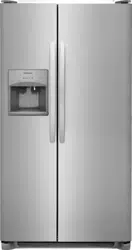Documents: Go to download!
User Manual
- User Manual - (English)
- Owner's Guide - (Spanish)
- Installation Instructions - (English)
- Product Specifications Sheet - (English)
- Energy Guide - (English)
- FEATURES AT A GLANCE
- INSTALLATION
- HANDLE INSTALLATION
- CONNECTING THE WATER SUPPLY
- CONTROLS
- CARE & CLEANING
- BEFORE YOU CALL
Table of contents
USER MANUAL Refrigerator
FEATURES AT A GLANCE
Features may vary according to model
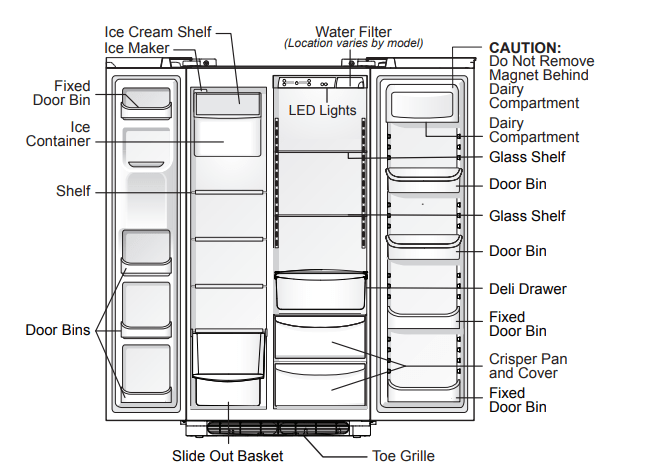
INSTALLATION
This Use & Care Guide provides general operating instructions for your model. Use the refrigerator only as instructed in this Use & Care Guide. Before starting the refrigerator, follow these important first steps.
Location
- Choose a place that is near a grounded electrical outlet. Do Not use an extension cord or an adapter plug.
- If possible, place the refrigerator out of direct sunlight and away from the range, dishwasher or other heat sources.
- The refrigerator must be installed on a floor that is level and strong enough to support a fully loaded refrigerator.
- Consider water supply availability for models equipped with an automatic ice maker. If you do not hook up water to the refrigerator, remember to turn the ice maker off.
Toe Grille Installation and Removal
To install toe grille
- Open both doors. Slide left and right sides of toe grille over lower hinges of refrigerator.
- While pushing toe grille firmly against cabinet, fasten bottom clips of toe grille to cabinet.
- Fasten top clips to cabinet.
- Close the doors. Fasten right and left side clips into groove of bottom hinge.

To remove toe grille
- With both doors closed, unfasten right and left side clips of toe grille from bottom hinge groove.
- Open both doors. Press firmly on top of toe grille until top of toe grille pops off.
- Pull toe grille outward toward your body and off of lower hinges.
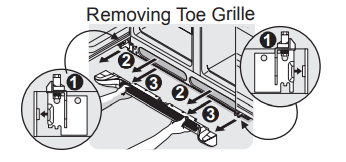
Door Opening
- Your refrigerator should be positioned to allow easy access to a counter or table when removing food. For best use of drawers and freezer baskets, the refrigerator should be in a position where both the refrigerator and freezer doors can be fully opened
Guidelines for final positioning of your refrigerator:
- All 4 corners of the cabinet must rest firmly on the floor.
- The cabinet should be level at the front and rear.
- The sides should tilt ¼ inch (6 mm) from front to back (to ensure that doors close and seal properly).
- Doors should align with each other and be level.
All of these conditions can be met by raising or lowering the adjustable front rollers.
To level the cabinet using the front rollers:
- Open both doors and remove the toe grille
- Close the doors and use a flat-blade screwdriver or 3 /8 inch socket wrench to raise or lower the front rollers.
- Ensure both doors are bind-free with their seals touching the cabinet on all 4 sides
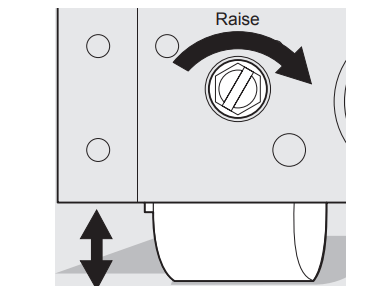 .
.
To level the doors using the adjustable lower hinge:
- Before leveling either door, remove set screw that locks door height into position. (The door cannot be adjusted without set screw removed).
- If the refrigerator door is lower than the freezer door, raise the refrigerator door by turning the adjustment screw clockwise using a 7 /16 inch wrench.
- If the freezer door is lower than the refrigerator door, raise the freezer door by turning the adjustment screw clockwise using a 7 /16 inch wrench.
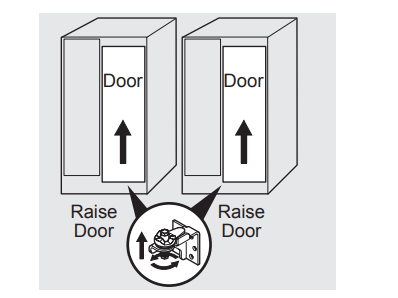
- After leveling, verify door stop contacts lower hinge and top of door does not contact upper hinge through full movement of door (from fully closed to fully open).

- Reinstall set screw, locking the door height.
- Replace the toe grille by fitting it into place
HANDLE INSTALLATION
- Remove handles from carton and any other protective packaging.
- Position freezer handle end caps over upper and lower pre-installed shoulder bolts (A) that are fastened into door, ensuring the holes for the set screws are facing towards the refrigerator door.
- While holding handle firmly against door, fasten upper and lower Allen set screws (B) with supplied Allen wrench.
- Repeat steps 2 and 3 to install refrigerator handle. Ensure the holes for the set screws are facing towards the freezer door.
NOTE: All set screws should be tightened and sub-flush (Allen set screw should be seated just below the surface of the end cap) of handle end cap. The end caps should be drawn tight to freezer and refrigerator doors with no gaps.
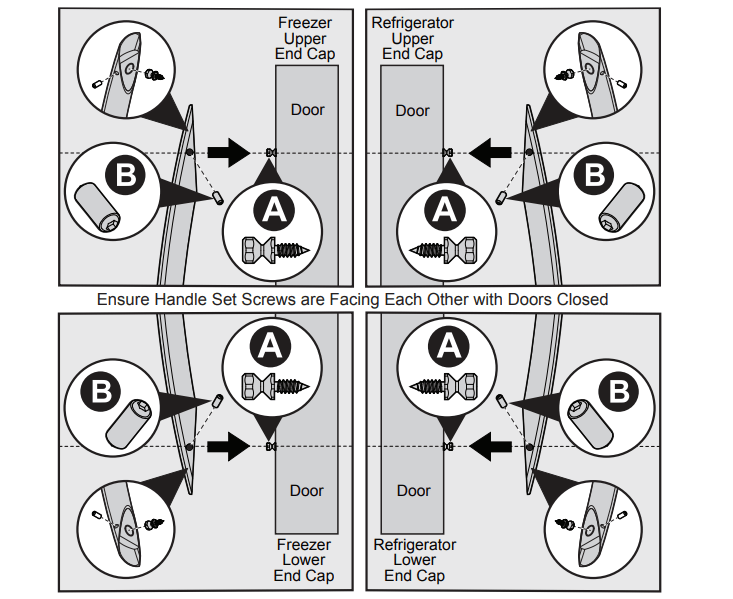
CONNECTING THE WATER SUPPLY
CAUTION: To Avoid Property Damage:
- Copper or Stainless Steel braided tubing is recommended for the water supply line. Water supply tubing made of ¼ inch plastic is not recommended to be used. Plastic tubing greatly increases the potential for water leaks, and the manufacturer will not be responsible for any damage if plastic tubing is used for the supply line.
- DO NOT install water supply tubing in areas where temperatures fall below freezing.
- Chemicals from a malfunctioning softener can damage the ice maker. If the ice maker is connected to soft water, ensure that the softener is maintained and working properly
Before Installing The Water Supply Line, You Will Need:
- Basic Tools: adjustable wrench, flat-blade screwdriver, and PhillipsTM screwdriver
- Access to a household cold water line with water pressure between 30 and 100 psi.
- A water supply line made of ¼ inch (6.4mm) OD, copper or stainless steel tubing. To determine the length of tubing needed, measure the distance from the ice maker inlet valve at the back of the refrigerator to your cold water pipe. Then add approximately 7 feet (2.1 meters), so the refrigerator can be moved out for cleaning (as shown).
- A shutoff valve to connect the water supply line to your household water system. DO NOT use a self-piercing type shutoff valve.
- Do not re-use compression fitting or use thread seal tape.
- A compression nut and ferrule (sleeve) for connecting a copper water supply line to the ice maker inlet valve.
To Connect Water Supply Line To Ice Maker Inlet Valve

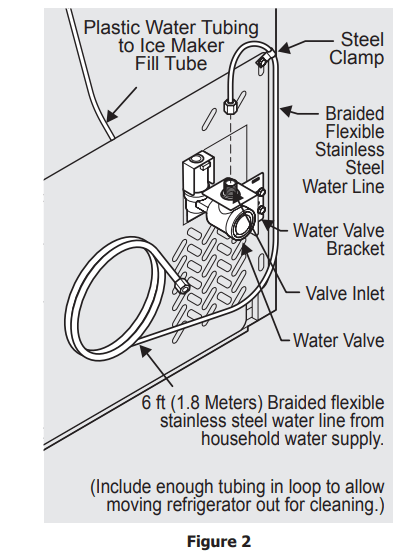
- Disconnect refrigerator from electric power source.
- Place end of water supply line into sink or bucket. Turn ON water supply and flush supply line until water is clear. Turn OFF water supply at shutoff valve.
- Remove plastic cap from water valve inlet and discard cap.
- If you use copper tubing - Slide brass compression nut, then ferrule (sleeve) onto water supply line. Push water supply line into water valve inlet as far as it will go (¼ inch/6.4 mm). Slide ferrule (sleeve) into valve inlet and finger tighten compression nut onto valve. Tighten another half turn with a wrench; DO NOT over tighten. See Figure 1. If you use braided flexible stainless steel tubing - The nut is already assembled on the tubing. Slide nut onto valve inlet and finger tighten nut onto valve. Tighten another half turn with a wrench; DO NOT overtighten. See Figure 2.
- With steel clamp and screw, secure water supply line (copper tubing only) to rear panel of refrigerator as shown.
- Coil excess water supply line (copper tubing only), about 2½ turns, behind refrigerator as shown and arrange coils so they do not vibrate or wear against any other surface.
- Turn ON water supply at shutoff valve and tighten any connections that leak.
- Reconnect refrigerator to electrical power source.
- To turn ice maker on, lower wire signal arm.
CONTROLS
Allowing Cooling Time Before Use
- To ensure safe food storage, allow your refrigerator to operate with the doors closed for at least 8 to 12 hours before placing food inside. During this cooling period, you do not need to adjust the controls, which are preset at the factory
Setting Cooling Temperatures
- Your refrigerator comes with a state-of-the-art electronic digital control system. The system’s control panel is located at the top of the refrigerator compartment.
- The 2 digital displays on the left half of the control panel indicate the current settings of your freezer and refrigerator compartments. Should you desire to see what the current accurate temperature is, place a separate thermometer inside the freezer or refrigerator compartment in the desired location.
Temperature Adjustment
- To adjust the temperature to a higher or lower setting, press the Up (∧) or Down (∨) button closest to the display. The first time you press the button, the display shows current setting you entered. Each press of the button after that changes the setting by one.

If Temperature Displays Flash...
- If ever you see “OP” or “SH” flashing, it may indicate that the control system has detected a performance problem. Call your service representative, who can interpret the flashing message.
- To maintain temperatures, a fan circulates air in the refrigerator and freezer compartments. For good circulation, do not block cold air vents with food items.

Alarms
Power Fail
- In the event of a power failure, the ‘power fail’ alarm will sound three times. The ‘power fail’ alarm is an audible alarm only and does not display in the control panel.
High Temperature
- When a warm refrigerator is first powered on, the ‘power fail’ alarm will sound and the current set points will be displayed for a few seconds. After 20 minutes the ‘high temp’ alarm will sound if the freezer temperature is above 26°F or if the refrigerator temperature is above 55°F (or both are above).
- If the unit is above the temperatures mentioned in the paragraph above, the affected compartment temperature display (refrigerator, freezer or both) on the control panel will display ‘HI’ and an alarm will sound. To disable the alarm press any key on the control panel. After which the control panel will then show the display temperature. The unit will continue to monitor the product temperatures for ‘high temp’ condition every 20 minutes. If the ‘high temp’ condition persists, the alarm will sound again and can be reset again. Contact a customer service representative if the high temp alarm continues.
- The audible portion of the alarm will silence itself once the product temperature is below 26°F for the freezer temperature and 55°F for the refrigerator temperature. The control panel will still show ‘HI’ until it is acknowledged by the user by pressing any key on the control panel. After which the control panel will then show the display temperature.
Turning the Cooling system on and off
You can disable the cooling system in your refrigerator by pressing the On/Off button located on the left side of the temperature control panel. To ensure that you do not accidentally turn off the cooling system, the button does not work unless you press and hold it for three seconds. Once you disable the cooling system, all refrigeration to the freezer and refrigerator compartments stops. To turn the cooling system back on, you must again press and hold the On/Off button for three more seconds. Controls will display OFOF/OFOF when turned off.
NOTE: Pressing the On/Off button on the control panel disables your refrigerator’s cooling system but does not disconnect power to lights and other electrical components. To turn off power to your refrigerator you must unplug the power cord from the wall outlet. Each time you make settings on the control panel, a single audible tone acknowledges your input.
CARE & CLEANING
Protecting your investment
Keeping your refrigerator clean maintains appearance and prevents odor build-up. Wipe up any spills immediately and clean the freezer and refrigerator compartments at least twice a year. When cleaning, take the following precautions:
- Never use CHLORIDE or cleaners with bleach to clean stainless steel.
- Do not wash any removable parts in a dishwasher.
- Always unplug the electrical power cord from the wall outlet before cleaning.
- Remove adhesive labels by hand. Do not use razor blades or other sharp instruments which can scratch the appliance surface.
- Do not remove the serial plate.
Do not use abrasive cleaners such as window sprays, scouring cleansers, brushes, flammable fluids, cleaning waxes, concentrated detergents, bleaches or cleansers containing petroleum products on plastic parts, interior doors, gaskets or cabinet liners. Do not use paper towels, metallic scouring pads, or other abrasive cleaning materials or strong alkaline solutions.
Care & Cleaning Tips
Interior & Door Liners
What To Use
- Soap and water
- Baking soda and water
Tips and Precautions
- Use two tablespoons of baking soda in one quart of warm water. Be sure to wring excess water out of sponge or cloth before cleaning around controls, light bulb or any electrical part.
Door Gaskets
What To Use
- Soap and water
Tips and Precautions
- Wipe gaskets with a clean soft cloth.
Drawers & Bins
What To Use
- Soap and water
Tips and Precautions
- Use a soft cloth to clean drawer runners and tracks.
Glass Shelves
What To Use
- Soap and water
- Glass cleaner
- Mild liquid sprays
Tips and Precautions
- Allow glass to warm to room temperature before immersing in warm water.
Toe Grille
What To Use
- Soap and water
- Mild liquid sprays
- Vacuum attachment
Tips and Precautions
- Vacuum dust from front of toe grille. Remove toe grille (see Installation Instructions). Vacuum backside, wipe with sudsy cloth or sponge. Rinse and dry.
Exterior & Handles
What To Use
- Soap and water
- Non Abrasive Glass Cleaner
Tips and Precautions
- Do not use commercial household cleaners containing ammonia, bleach or alcohol to clean handles. Use a soft cloth to clean smooth handles. DO NOT use a dry cloth to clean smooth doors.
Exterior & Handles (Stainless Steel Models Only)
What To Use
- Soap and water
- Stainless Steel Cleaners
Tips and Precautions
- Never use CHLORIDE or cleaners with bleach to clean stainless steel. Clean stainless steel front and handles with non-abrasive soapy water and a dishcloth. Rinse with clean water and a soft cloth. Use a non-abrasive stainless steel cleaner. These cleaners can be purchased at most home improvement or major department stores. Always follow manufacturer’s instructions. Do not use household cleaners containing ammonia or bleach.
- NOTE: Always clean, wipe and dry with the grain to prevent scratching. Wash the rest of the cabinet with warm water and mild liquid detergent. Rinse well, and wipe dry with a clean soft cloth.
Replacing LED Bulbs
What To Use
- Unplug refrigerator
- Wear gloves
- Remove light cover
- Replace old LED bulb
- Replace light cover
- Plug in the refrigerator
Tips and Precautions
- CAUTION: Wear gloves when replacing LED bulbs to avoid getting cut.
- Use same wattage when replacing LED bulb.
BEFORE YOU CALL
AUTOMATIC ICE MAKER
Ice maker is not making any ice.
- Ice maker wire signal arm is in the “up” or OFF position.
- Move wire signal arm to the “down” or ON position (side mounted).
- Ice maker has small cube caught in mechanism.
- Remove small cube from ice maker. The ice and water filter cartridge may be clogged. Replace filter cartridge.
- Saddle valve on cold water pipe is clogged or restricted by foreign material.
- Turn off household water line valve. Remove valve. Ensure that valve is not a self-piercing saddle valve. Clean valve. Replace valve if necessary.
Ice maker is not making enough ice.
- Ice maker is producing less ice than you expect.
- Side mounted ice maker should produce 4 to 4.5 pounds (approximately 4 quarts) of ice every 24 hours.
- Check to see if water dispenser is dispensing slower than normal.
- If it is, replace the ice and water filter cartridge.
- Freezer control is set too warm.
- Set freezer control to colder setting to improve performance of the ice maker. Allow 24 hours for temperature to stabilize.
Ice maker will not stop making ice
- Ice maker wire signal arm is being held down by some item in the freezer.
- Move item and release wire signal arm. Remove any ice cubes that are frozen together over the wire signal arm.
Ice cubes are freezing together.
- Ice cubes are not being used frequently enough.
- Remove ice container and discard ice from container. Ice maker will produce fresh supply.
- Ice cubes are hollow (partially frozen cubes with water inside).
- The ice and water filter cartridge may be clogged. Replace filter cartridge.
- Freezer control is set too warm.
- Set freezer control to colder setting. Allow 24 hours for temperature to stabilize.
DISPENSER (Ice & Water)
Dispenser will not dispense ice.
- Dispenser lock out is engaged.
- Press and hold control lock for three seconds.
- There is no ice in the bin to be dispensed.
- See the “Ice maker is not making any ice” section above.
- The refrigerator doors are not completely closed.
- Be sure the refrigerator doors are completely closed.
- Dispenser paddle has been pressed too long and the dispenser motor has overheated.
- The motor overload protector will reset in about three minutes and then ice can be dispensed
Ice dispenser is jammed.
- Ice has melted and frozen around auger due to infrequent use, temperature fluctuations, and/or power outages.
- Remove ice container, thaw, and empty the contents. Clean container, wipe dry, and replace in proper position. When new ice is made, dispenser should operate.
- Ice cubes are jammed between ice maker and back of ice container.
- Remove ice cubes that are jamming the dispenser.
Dispenser will not dispense water.
- Dispenser lock out is engaged.
- Press and hold control lock for three seconds
- Water filter not seated properly.
- Remove and reinstall the water filter. Be sure to push the filter firmly so that you hear it lock solidly into position
- Water filter is clogged.
- Replace filter cartridge. Be sure to remove protective caps and push the filter firmly so that you hear it lock solidly into position.
- Household water line valve is not open.
- Open household water line valve. See CONCERN column AUTOMATIC ICE MAKER.
Water has an odd taste and/ or odor.
- Water has not been dispensed for an extended period of time.
- Draw and discard 10-12 glasses of water to freshen the supply
- Unit not properly connected to cold water line.
- Connect unit to cold water line that supplies water to the kitchen faucet.
Water has an odd taste and/ or odor.
- Water has not been dispensed for an extended period of time.
- Draw and discard 10-12 glasses of water to freshen the supply
- Unit not properly connected to cold water line.
- Connect unit to cold water line that supplies water to the kitchen faucet.
Water pressure is extremely low.
- Cut-off and cut-on pressures are too low (well systems only).
- Have someone turn up the cut-off and cut-on pressure on the water pump system (well systems only).
- Reverse osmosis system is in regenerative phase
- It is normal for a reverse osmosis system to be below 20 psi during the regenerative phase.
Water not cold enough
- As warmer tap water goes through the filter and enters the water tank the chilled water is pushed through to the dispenser. Once the chilled water is used up it will take several hours to bring the freshly replaced water to a cooler temperature.
- Add ice to cup or container before dispensing water.
- Some models are designed without a water tank, these water dispensing systems are not designed to chill water.
- Add ice to cup or container before dispensing water
OPENING/CLOSING OF DOORS/DRAWERS
Door(s) will not close.
- Door was closed too hard, causing other door to open slightly.
- Close both doors gently
- Refrigerator is not level. It rocks on the floor when moved slightly.
- Ensure floor is level and solid, and can adequately support the refrigerator. Contact a carpenter to correct a sagging or sloping floor
- Refrigerator is touching a wall or cabinet.
- Ensure floor is level and solid, and can adequately support the refrigerator. Contact a carpenter to correct a sagging or sloping floor.
Drawers are difficult to move.
- Food is touching shelf on top of drawer.
- Remove top layer of items in drawer.
- Track that drawers slide on is dirty.
- Ensure drawer is properly installed on track.
- Clean drawer, rollers, and track. See Care & Cleaning.
RUNNING OF REFRIGERATOR
Compressor does not run.
- Freezer control is set to “OF” or “0”.
- Set freezer control.
- Refrigerator is in defrost cycle.
- This is normal for a fully automatic defrost refrigerator. The defrost cycle occurs periodically, lasting about 30 minutes.
- Plug at electrical outlet is disconnected.
- Ensure plug is tightly pushed into outlet.
- House fuse blown or tripped circuit breaker.
- Check/replace fuse with a 15 amp timedelay fuse. Reset circuit breaker
- Power outage.
- Check house lights. Call local electric company.
Refrigerator runs too much or too long
- Room or outside weather is hot.
- It’s normal for the refrigerator to work longer under these conditions.
- Doors are opened too frequently or too long
- Warm air entering the refrigerator causes it to run more. Open doors less often..
- Refrigerator/freezer door may be slightly open.
- Ensure refrigerator is level. Keep food and contains from blocking door. See PROBLEM column OPENING/CLOSING OF DOORS/DRAWERS.
- Freezer control is set too cold.
- Set Refrigerator control to warmer setting until refrigerator temperature is satisfactory. Allow 24 hours for temperature to stabilize.
- Refrigerator/freezer gasket is dirty, worn, cracked, or poorly fitted.
- Clean or change gasket. Leaks in door seal will cause refrigerator to run longer in order to maintain desired temperatures.
- Condenser is dirty
- Clean condenser. See Care & Cleaning.
Compressor goes off and on frequently.
- Thermostat keeps the refrigerator at a constant temperature.
- This is normal. Refrigerator goes on and off to keep temperature constant.
DIGITAL TEMPERATURE DISPLAY
Digital temperature displays are flashing.
- Electronic control system has detected a performance problem.
- Call your Frigidaire service representative, who can interpret any messages or number codes flashing on the digital displays.
WATER/MOISTURE/FROST INSIDE REFRIGERATOR
Moisture collects on inside of refrigerator walls.
- Weather is hot and humid.
- The rate of frost buildup and internal sweating increases.
- Door is slightly open.
- See PROBLEM column OPENING/CLOSING OF DOORS/DRAWERS.
Water collects on bottom side of drawer cover.
- Vegetables contain and give off moisture.
- It is not unusual to have moisture on the bottom side of the cover.
- Move humidity control (some models) to lower setting.
Water collects in bottom of drawer.
- Washed vegetables and fruit drain while in the drawer.
- Dry items before putting them in the drawer. Water collecting in bottom of drawer is normal.
WATER/MOISTURE/FROST OUTSIDE REFRIGERATOR
Moisture collects on outside of refrigerator or between doors.
- Weather is humid.
- This is normal in humid weather. When humidity is lower, the moisture should disappear
- Door is slightly open, causing cold air from inside refrigerator to meet warm air from outside.
- See PROBLEM column OPENING/CLOSING OF DOORS/DRAWERS.
See other models: FFHT1821QB FFRA1022R1 FGF318GC FGHB2846LF LFGF3022LS
